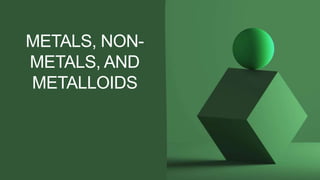
Metals, non metals, and metalloids
- 2. Learning Goals DESCRIBE THE PROPERTIES OF TYPICAL METALS, NONMETALS, AND METALLOIDS. CLASSIFY ELEMENTS INTO METALS, NON-METALS, AND METALLOIDS. RECOGNIZE THE IMPORTANCE OF METALS, NON-METALS , AND METALLOIDS.
- 3. ELEMENTS •
- 4.
- 6. Metals
- 7. Properties of Metals Metals appear to the left of the dark ziz-zag line on the periodic table. Most metals are solid at room temperature.
- 8. Properties of Metals Metals have luster. This means they are shiny
- 10. Properties of Metals Malleable metals can be hammered into sheets
- 11. Properties of Metals high melting point
- 13. When you leave a spoon in a cup of hot drink, the bit poking out of the drink gets hot. Why? Conduction! METALS are the best conductors of heat. Best conductors: silver and copper
- 14. Properties of Metals A chemical property of metal is its reaction with water and oxygen. This results in corrosion and rust.
- 15. ALKALI METALS Group 1 – soft and shiny React by losing 1 electron, never found uncombined in nature Na and K important elements for life Li – batteries and some medicines ALKALINE EARTH METALS Fairly hard, gray-white, good conductors of electricity React by losing 2 electrons More reactive than most metals but less than family 1 Mg and Ca most common TRANSITION METALS Hard, shiny, good conductors of heat and electricity Many form colorful compounds Less reactive; used in jewelry Fe – essential for hemoglobin production
- 16. METALS in groups 13-15 Less reactive AL used in cans and airplanes Sn – thin coating protects steel from corrosion Pb (poisonous) used in batteries LANTHANIDES • Soft, shiny, malleable metals with high conductivity • Used in alloys with more common elements • Found together in nature; difficult to separate because they share common properties ACTINIDES • Ac, Th, Pa, and U are found in nature • All others are synthetic elements made in particle accelerators
- 18. Uses of metals :- • • • • • • • •
- 19. Nonmetals
- 26. Carbon Family • Gain or lose 4 electrons • Compounds made from C are found in all living things • Most fuels that are burned for energy contain C, coal, gasoline, oil Nitrogen Family • N and P gain or share 3 electrons • Atmosphere is 78% N2, a diatomic molecule • all living things need N but cannot process it • P is more reactive, always found in compounds in nature **Diatomic Molecule – two atoms of the same element bonded together
- 27. Oxygen • Usually gains or shares 2 electrons; O, S, Se • O is most abundant element in crust and 21% of atmosphere • O2 – diatomic molecule living things breathe • O3 – triatomic molecule; Ozone in upper atmosphere – screens out harmful radiation from the sun Ozone at ground level it is a dangerous pollutant – highly reactive Halogens – means salt-forming Gains or shares 1 electron F – used to prevent tooth decay, non-stick pans Cl – used to kill bacteria, NaCl, CaCl melts ice on roads Br – used in photographic film I – medical uses
- 28. NOBLE/INERT GASES Do not usually gain, lose, or share electrons Found in small amounts in atmosphere He balloons Neon lights also made with Xe and Ar HYDROGEN • Doesn’t have a family because of its unique properties • 90% of the atoms of the universe • Only 1% of earth’s of mass of Earth’s crust, oceans, and atmosphere • Most is found in the form of water
- 29. 8) Uses of non metals :- Sulphur :- is used for making sulphuric acid, salts of metals etc. Oxygen :- is used for respiration by living things, burning of fuels etc. Nitrogen :- is used for making ammonia which is used for making fertilizers. Hydrogen :- is used for making ammonia which is used for making fertilizers, as fuel in rockets, for welding etc. Chlorine :- is used to kill germs in water. Iodine :- is used as tincture iodine which is an antiseptic.
- 30. Metalloids
- 33. Properties of Metalloids shiny dull
- 36. Si – combine with O to form sand; used to make glass B – a compound of B and O is used during the glass-making process to make heat resistant glass; also used in cleaning materials Useful as semiconductors which conduct under some conditions but not others computer chips- Metalloids
- 37. LET’S SUM IT UP!!! What are the three classifications of elements? Where can we find metals? Non—metals? Metalloids? Give the characteristics of each type. Cite some uses of metals? Non-metals? Metalloids?
- 39. WHERE DO I BELONG? METALS NON-METALS METALLOIDS Al Ne Cu Ar Mg Pb Zn As C Ag I Ca S P Si Ge Po Sb O Fr LUSTER MALLEABLE MOSTLY SOLID BRITTLE REACTIVE GOOD CONDUCTORS ZIGZAG LINE IN THE TABLE LEFT SIDE OF THE TABLE CORROSIVE DUCTILE POOR CONDUCTOR SEMI-CONDUCTORS RIGHT SIDE OF THE TABLE DULL CAN BE SHINY OR DULL